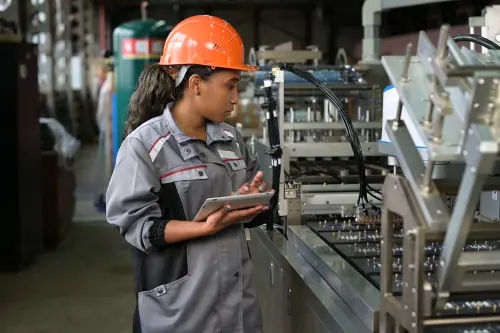Women’s labor force participation has increased substantially in the U.S. over the second half of the 20th century, yet this growth has stagnated and reversed since 2000. Today, large gaps remain between men and women in employment rates, the jobs they hold, the wages they earn, and their overall economic security.
According to The 51%: Driving Growth through Women’s Economic Participation, a new e-book from the Hamilton Project at Brookings, these trends are not only troubling for the women who struggle to achieve career and financial success—they’re also a major economic concern for the country. The authors find that barriers to workforce participation for women are stifling the growth of the U.S. economy, and that future economic success hinges on improving career prospects and working environments for all women.
The book explores the state of women in the American workforce and offers policy solutions for problems in labor markets, taxes, and employment policy that are inhibiting women—and the nation—from reaching their full potential. The authors argue that this new research shows that making optimal use of women’s talents and drive must become an urgent priority for anyone who is concerned about America’s economic success.
Below are 10 facts about women in the workforce, derived from the 10 chapters of the e-book. And once you’ve digested these facts, you can download the free e-book, and watch authors and experts, including Facebook COO Sheryl Sandberg, discuss these findings during a joint forum hosted by the Hamilton Project, LeanIn.Org, and Stanford Law School.
1. Women’s labor force participation has stagnated and reversed since 2000
Over the past half century, women have made substantial progress in the labor market. Between 1962 and 2000, women’s labor force participation—defined as the percentage of women ages 16 and older either working or actively looking for work—increased dramatically, from 37 percent to 61 percent, leading to economic gains of an estimated $2 trillion.
However, beginning in 2000, the positive trend slowed and even reversed: women’s participation fell from 60.7 percent in 2000 to 57.2 percent in 2016. According to Sandra E. Black, Diane Whitmore Schanzenbach, and Audrey Breitwieser, this pattern persists across women of varying races and ethnicities, educational backgrounds, ages, and marital statuses, and for women with and without children alike. The authors also note that this decline seems to be moving against the trends observed in other major OECD economies.
2. The gap between wages of men and women has fallen over the past several decades, but a significant gender wage gap remains
One of the most important economic developments of the 20th century was the improvement in educational and labor market opportunities for women. As a result of this progress, tens of millions of American women attained postsecondary degrees, entered the labor force, and earned wages that have grown over time.

However, according to Ryan Nunn and Megan Mumford, women’s labor market outcomes—and in particular their earnings—do not yet equal those of men, even though women’s educational attainment has surpassed that of men.

Factors that underlie much of the remaining gender wage gap include occupational segregation, differences in academic specialization, difficulty in balancing work and household responsibilities, and wage discrimination.
3. Almost 60% of women would earn more if they were paid the same as men with equivalent levels of education and work hours
Even if outdated labor laws and institutions that hold women back were addressed and work-family challenges were more easily met, Bridget Ansel and Heather Boushey argue that discrimination would continue to drive the gender gap.
According to one recent study, after adjusting for factors like labor force experience, union status, race and ethnicity, and occupation, much of the gender wage gap remains unexplained, suggesting that labor market discrimination plays an important role. In fact, the authors say, almost 60 percent of women would earn more if they were paid the same as men with equivalent levels of education and work hours.
4. Disability and widowhood are major drivers of economic insecurity among older women
According to Jason Brown and Karen Dynan, women earn less over their lifetimes but have longer life expectancies than men, which often makes their economic security as they age a concern. In fact, women 65 and older are twice as likely as men the same age to live in poverty. But there are specific factors, particularly the death of a spouse or onset of a disability, that leave women especially vulnerable to economic insecurity later in life.
Brown and Dynan argue that retirement policies should better serve such women. They propose offering Social Security beneficiaries the option of purchasing long-term care insurance, and allowing beneficiaries to choose reduced Social Security payments while both spouses are living, in exchange for larger payments for a surviving spouse.
5. A 10% expansion of the EITC could benefit working mothers and families by lifting more than 600,000 people out of poverty
According to Hilary Hoynes, Jesse Rothstein, and Krista Ruffini, earnings prospects for lower-skilled workers (many of whom are women) have stagnated or diminished over the past several decades, and prime-age employment rates have fallen. Despite strong evidence that the Earned Income Tax Credit (EITC) is highly effective at increasing employment and reducing poverty by increasing take home pay for low-skill parents, the maximum EITC benefit has been frozen in inflation-adjusted terms for most families since 1996. This means that the 25 million EITC families with fewer than three children have not seen a real increase in more than 20 years.

The authors propose building on the successes of the EITC by implementing a 10 percent across-the-board increase in the federal credit. They argue that this expansion would provide a meaningful offset to stagnating wages, encourage more people to enter employment, lift approximately 600,000 individuals out of poverty, and improve health and education outcomes for millions of children.
6. Many women face a tax penalty when they get married, which reduces their labor force participation.
Though it’s well known that women earn less than men, it’s less well known that the gap between women’s earnings and men’s earnings would be even larger if measured in after-tax terms. According to Sara LaLumia, the tax treatment of married couples tends to raise the tax rate for the spouse who is the lower earner in a couple, and in most couples, that secondary earner is female.
Since 1948, the United States has used a policy of joint taxation, which taxes a married couple as a unit on the basis of the combined income of husband and wife. By making a wife’s tax rate dependent on her husband’s earnings, joint taxation raises wives’ tax rates, on average, and reduces their labor supply.
In order to address this, LaLumia proposes implementing a new second-earner tax deduction, equal to 15 percent of the earnings of a lower-earning spouse. The proposed deduction would raise the after-tax return to work for many wives, encouraging an increase in married women’s labor supply, and would reduce marriage penalties on average.
7. Women are more likely than men to stop working to care for elderly family members
By 2030, nearly one in five Americans will be age 65 or older. As the population ages, more and more Americans will experience health problems and functional limitations, and require additional care. Though some of this care can be provided by institutions, Nicole Maestas points out that most of it will fall to family members. Currently, women make up 60 percent of these caregivers.
Masestas explains that much of the substantial burden of caregiving rests on the shoulders of working people. Many in this position are forced to choose between working and caregiving because they can’t be absent from work for short periods of time and on short notice, and when faced with this choice women are more likely than men to stop working.
In order to allow more people to remain in the workforce while caring for family members, Maestas proposes a federal earned sick leave mandate guaranteeing one hour of flexible, multi-purpose sick leave for every 30 hours worked. By helping workers periodically adjust their schedules to accommodate intermittent and urgent caregiving activities, paid sick leave would increase both home caregiving and employment, as fewer workers would be forced to choose between these activities. This proposal would be especially helpful to low-income workers, who have fewer financial resources for their elder family’s care.
8. The U.S. is the only industrialized country without a national paid leave policy for mothers
Despite research that indicates that providing paid parental leaving following the birth of a child provides significant labor market and health benefits, the United States is the only industrialized country without a national policy providing mothers with rights to paid leave following the birth of a child. (Most industrialized countries also offer fathers paid time off work, although often much less than they offer mothers.)
 And according to Christopher J. Ruhm, U.S. companies aren’t doing much to fill the gap left by the absence of a national leave policy: In 2014 just 14 percent of U.S. workers had employer-sponsored paid family leave coverage. And these rates were considerably lower for part-time, less-skilled, and low-wage workers, or for those employed in small firms, which Ruhm says is likely due to the costs for employers associated with these policies.
And according to Christopher J. Ruhm, U.S. companies aren’t doing much to fill the gap left by the absence of a national leave policy: In 2014 just 14 percent of U.S. workers had employer-sponsored paid family leave coverage. And these rates were considerably lower for part-time, less-skilled, and low-wage workers, or for those employed in small firms, which Ruhm says is likely due to the costs for employers associated with these policies.
Ruhm’s proposed solution is a national paid leave program that provides 12 weeks of paid time off work for both mothers and fathers, includes job protection, and wage replacement based on earnings and up to a maximum. This, says Ruhm, is modest in comparison to most other countries’ programs, but takes into consideration the uncertainty involved in applying international experiences to the United States.
9. The cost of childcare makes center-based care—if not employment itself—unrealistic for many working mothers of young children
Child care is a necessity for working women with young children. Yet, says Elizabeth Cascio, the costs of high-quality center-based child care in the United States—particularly for children under age five—are prohibitively high for many families: In 2016, the average center-based program for infants cost nearly $16,200 per year.
In order to support working mothers and provide the best possible outcomes for their children, Cascio proposes a multifaceted approach to child-care policy that reduces the financial burden of child care, encourages maternal employment, and supports child development. Her approach replaces existing federal childcare tax policies with a single refundable federal child-care tax credit that is more generous to lower-income families and families with children under the age of five. State and local governments, she says, could pursue these investments on their own or with federal assistance.
10. Postsecondary degrees lead to better labor outcomes, but many student mothers face significant challenges
Over the past few decades, women’s postsecondary enrollment has swelled, and for the past 20 years women have outpaced men in college attendance and degree attainment. This expanding pool of students, explains Bridget Terry Long, is comprised of more nontraditional students—many of whom are older, female, and have children.

Though higher education yields strong labor market benefits, including increased wages and lower rates of unemployment, Long notes juggling the responsibilities of parenthood with college is extremely difficult. Among women who entered college in 2003–04 without dependents, nearly 60 percent attained a credential (degree or certificate) within six years, and fewer than 30 percent dropped out with no credential. Among those with a dependent, the success rate was much lower. More than half of female student-parents dropped out with no credential, and fewer than one-third attained any credential at all.

Her proposed solution to this problem? Build upon the Federal Child Care Access Means Parents in School (CCAMPIS) Program to structure an institutional grant program that better supports the availability of high-quality child care for student parents.
Learn more by downloading the free e-book The 51%: Driving Growth through Women’s Economic Participation, and by watching authors and experts, including Facebook COO Sheryl Sandberg, discuss these findings during a joint forum hosted by the Hamilton Project, LeanIn.Org, and Stanford Law School.
The Brookings Institution is committed to quality, independence, and impact.
We are supported by a diverse array of funders. In line with our values and policies, each Brookings publication represents the sole views of its author(s).



Commentary
10 facts about American women in the workforce
December 5, 2017